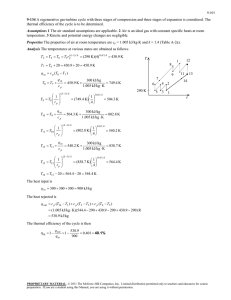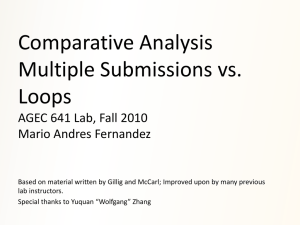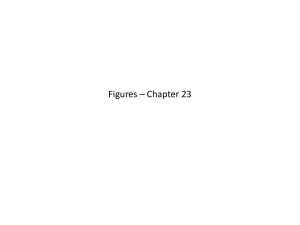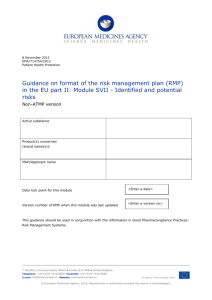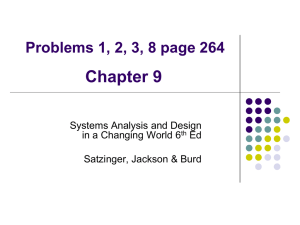Introduction to GAMS
advertisement
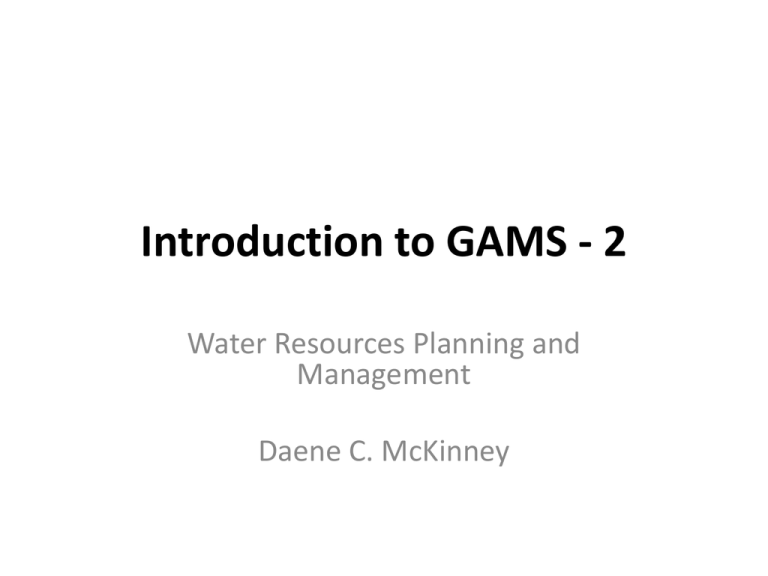
Introduction to GAMS - 2
Water Resources Planning and
Management
Daene C. McKinney
Capacity – Yield Example
• Use linear programming in GAMS to derive a capacity-yield (K
vs Y) function for a reservoir at a site having the following
record of flows 5, 7, 8, 4, 3, 3, 2, 1, 3, 6, 8, 9, 3, 4, 9 units of
flow.
• Find the values of the capacity required for yields of 2, 3, 3.5,
4, 4.5, and 5.
Y
St
Y
Qt
K
Rt
K
Capacity – Yield Curve
St
Y
Qt
Minimize K
K
subject to
Rt
St+1 = St + Qt - Rt - Y ; "t, T +1 = 1
St £ K ; "t
Y
K
The GAMS Code
Results: Yield = 5, Capacity = 14
Results: Yield = 5, Capacity = 14
Capacity
14
12
Yield
10
Q(t)
8
S(t)
SPILL(t)
6
Y
4
2
0
1
2
3
4
5
6
7
8
9
10 11 12 13 14 15
Capacity vs Yield Curve
6
5
Yield (L3/T)
4
3
2
1
0
0
2
4
6
8
10
Capacity (L3)
12
14
16
The DOLLAR Sign
S(t+1)$(ord(t) lt 15) + S('1')$(ord(t) eq 15) =e= S(t) + Q(t)- SPILL(t) - Y;
you can exclude part of an equation by using logical conditions ($ operator) in the
name of an equation or in the computation part of an equation.
The ORD operator returns an ordinal number equal to the index position in a set.
Management of a Single Reservoir
• 2 common tasks of reservoir modeling:
1. Determine coefficients of functions that
describe reservoir characteristics
2. Determine optimal mode of reservoir
operation (storage volumes, elevations and
releases) while satisfying downstream water
demands
Reservoir Operation
• Compute optimal operation of reservoir given a
series of inflows and downstream water demands
T
Minimize
å[ Rt - Dt ]
2
t=1
subject to
(1+ at )St = (1- at )St-1 + Qt - Rt - bt
t = 1,...,T
St £ K
St ³ Smin
where:
St End storage period t, (L3);
St-1 Beginning storage period t, (L3);
Qt Inflow period t, (L3);
Rt Release period t, (L3);
Dt Demand, (L3); and
K Capacity, (L3)
Smin Dead storage, (L3)
Comparison of Average and Dry Conditions
20000
18000
Flows & Volums (mill. m3)
16000
14000
Storage - Ave
Storage - Dry
Inflow - Ave
Inflow - Dry
Release
Demand
12000
10000
8000
6000
4000
2000
0
t0
t1
t2
t3
t4
t5
t6
t7
Time period (month)
t8
t9
t10
t11
t12
GAMS Code
SCALAR K
/19500/;
SCALAR S_min /5500/;
SCALAR beg_S /15000/;
Capacity
Dead storage
Beginning storage
SETS t / t1*t12/;
These $include statements allow
Us to read in lines from other files:
Flows (Q)
Demands (D)
Evaporation (at, bt)
$include River1B_Q_Dry.inc
$include River1B_D.inc
$include River1B_Evap.inc
VARIABLES obj;
POSITIVE VARIABLES S(t), R(t);
S.UP(t)=K;
S.LO(t)=S_min;
Set bounds on:
Capacity
Dead storage
GAMS Code (Cont.)
EQUATIONS objective, balance(t);
objective..
obj =E= SUM(t, (R(t)-D(t))*(R(t)-D(t)) );
balance(t)..
(1+a(t))*S(t) =E=
(1-a(t))*beg_S $(ord(t) EQ 1) +
First Time, t = 1, t-1 undefined
(1-a(t))*S(t-1)$(ord(t) GT 1) +
After First Time, t > 1, t-1 defined
Q(t) - R(t)- b(t);
at =
Aa et
2
bt = A0 et
We’ll preprocess these
$include Files
Flows (Q)
Parameter
Q(t) inflow (million m3)
* dry
/
t1 375
t2 361
t3 448
t4 518
t5 1696
t6 2246
t7 2155
t8 1552
t9 756
t10 531
t11 438
t12 343
/;
Demands (D)
Parameter
D(t) demand (million m3)
/
t1 1699.5
t2 1388.2
t3 1477.6
t4 1109.4
t5 594.6
t6 636.6
t7 1126.1
t8 1092.0
t9 510.8
t10 868.5
t11 1049.8
t12 1475.5
/;
Evaporation (at, bt)
Parameter
a(t) evaporation coefficient
/
t1 0.000046044
t2 0.00007674
…
t11 0.000103599
t12 0.000053718/;
Parameter
b(t) evaporation coefficient
/
t1 1.92
t2 3.2
…
t11 4.32
t12 2.24/;
Results
20000
Input
4000
Release Demand
18000
t0
15000
t1
13723
426
1700
1700
t2
12729
399
1388
1388
t3
11762
523
1478
1478
t4
11502
875
1109
1109
t5
12894
2026
595
595
t6
15838
3626
637
637
t7
17503
2841
1126
1126
t8
17838
1469
1092
1092
t9
18119
821
511
511
t10
17839
600
869
869
t11
17239
458
1050
1050
t12
16172
413
1476
1476
3500
16000
3000
Storage (million m3)
14000
2500
12000
10000
2000
8000
1500
6000
1000
4000
500
2000
0
0
1
2
3
4
5
6
7
8
9
10
Month
Storage
Release
Inflow
11
12
Release and Inflow (million m3)
Storage
